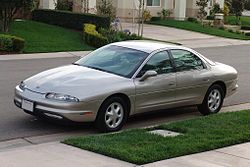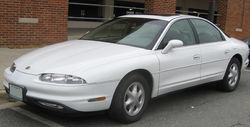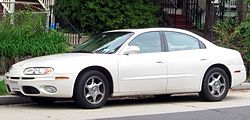- Oldsmobile Aurora
-
Oldsmobile Aurora 
Manufacturer General Motors Production January 1994–March 2003 Assembly Lake Orion, Michigan, United States Predecessor Oldsmobile Ninety-Eight Class Full-size sedan Body style 4-door sedan Layout FF layout Platform G-body Transmission 4-speed automatic The Oldsmobile Aurora was a full-size sports sedan made by the Oldsmobile division of General Motors and launched in 1995. The Aurora rode on the same Cadillac-derived G platform as the 2-door Buick Riviera.
The Aurora became the high-end sport sedan Oldsmobile powered by a 4 cam 32 valve 4.0L V-8 supplanting the Oldsmobile Toronado coupe and eventually the Oldsmobile 98 in the line-up. The Aurora offered both the V6-powered version and a V-8 powered version from 2001-03. It was equipped with a 4-speed automatic transmission with performance algorithm shifting.
Contents
Introduction
Since the 1980s GM had wanted a new car to bring new life to Oldsmobile, a car that was "not your father's Oldsmobile"; thus the Aurora was born, with several styling cues taken from the 1960s Oldsmobile Toronado.[1] By the time the Aurora was released, Oldsmobile badly needed the Aurora, in hopes for a comeback of the marque (Oldsmobile sales had plummeted from 1,066,122 in 1985, to just 389,173 in 1992). As a symbol of its clean break from other cars in the lineup, the Aurora bore no Oldsmobile badging or script save for the radio/CD/cassette deck and engine cover. Instead, a new emblem consisting of a stylized 'A' was used, foreshadowing a similar restyling of Oldsmobile's corporate 'Rocket' emblem for 1997.[2]
With the Aurora, Oldsmobile tried to ride the praise of the car by launching other models that borrowed styling cues from the Aurora such as the mid-size Intrigue and compact Alero, as well as the redesigned Eighty-Eight, Silhouette, Cutlass, and Bravada. The Oldsmobile "rocket" logo was even updated to be more in-line with the Aurora's emblem.
Conceptualization
Early design work on what would become the Aurora began as early as the late 1980s and manifested itself with a 1989 engineering concept known as the Oldsmobile Tube Car. Beyond the overall similar shape, the Tube Car featured many detailed elements that were later found on the production automobile, including a full-width taillamp, wraparound rear windshield, and frameless windows. Unlike the eventual production car, the Tube Car was of a pillarless hardtop design with suicide doors.[3]
First generation (1995–1999)
First generation 
Production January 1994–June 1999 Model years 1995–1999 Engine 4.0 L L47 V8 Wheelbase 113.8 in (2,891 mm) Length 205.4 in (5,217 mm) Width 74.4 in (1,890 mm) Height 55.4 in (1,407 mm) Curb weight 3,967 lb (1,799 kg) Related Buick Riviera
Buick Park Avenue
Cadillac Seville
Cadillac DeVilleAfter much research and development, the Aurora went into production on January 24, 1994,[4] and was released for the 1995 model year. It hosted a number of luxury and technologically advanced standard features including dual-zone climate control, driver and front passenger airbags, leather seating surfaces, genuine burl walnut interior accents, 6-speaker sound system with in-dash cd/cassette, and 8-way power adjustable front seats with 2-position memory.[5] Only several options were available on the Aurora including heated seats, power sunroof, 12-disc cd changer, and an Autobahn package. An onboard computer displaying the date, current gas consumption, and other information was also standard.
 The Aurora's 4.0 L V8.
The Aurora's 4.0 L V8.
The Aurora also came standard with Oldsmobile's 4.0 L (244 cu in) L47 V8 engine, a DOHC engine based on Cadillac's 4.6 L Northstar V8. The Northstar engine and 4T80-E had been exclusive to Cadillac prior to the Aurora. The L47 put out 250 hp (186 kW) at 5600 rpm and 260 lb·ft (353 N·m) torque at 4400 rpm.[6] The Aurora used a 4-speed automatic transmission with driver selectable "normal" and "power" shift modes. A highly modified 650 hp (485 kW) version of this engine was used by General Motors racing division initially for Indy Racing League competition starting in 1995, then was later used in the Cadillac Northstar LMP program in 2000. Both engines retained the 4.0 L capacity, but the Northstar LMP version was twin-turbocharged.[7]
The Aurora had a drag coefficient of 0.32.[8]
The Aurora was highly regarded at the time for its refined engine, excellent build quality, well-balanced ride, and structural integrity. In fact, during normal crush-to-failure tests done by automakers to evaluate body rigidity, the Aurora's unibody construction actually broke GM's testing machine.[9] A frame-crusher otherwise used to test stronger truck frames had to be used instead, with the car exceeding federal standards for passenger cars by two times.
First year sales were strong, with the Aurora selling over 45,000 units, but sales dropped dramatically for 1996, as in many cases, buyers were turned away by the large price tag. All first-generation Auroras were built in Lake Orion, Michigan, along with the Buick LeSabre, Buick Park Avenue, Buick Riviera, Oldsmobile 88, Oldsmobile 98 and the Pontiac Bonneville. Production for this generation ended on June 25, 1999.[10]
Year-to-year changes
1996
For 1996, Oldsmobile made some minor revisions to the Aurora including new rear glass which has less distortion than previous models. Further revisions include daytime running lights and OBD II compliant On-Board Diagnostic systems, tweaking the climate control and safety alarm, a revised keyless entry system with new features was added, a 12 disc BOSE CD changer was made optional, and the short list of optional equipment was expanded to include Chrome wheels and a gold trim package. The 96-99 models also had the passenger temperature toggle button on the middle right portion of the instrument panel replaced with an air recirculator button.1997
There were minor changes for the Aurora in 1997. A new in-dash CD player for the BOSE sound system highlighted the improvements. Another new feature was a tilt-down right-outside mirror that enhances the driver's view of close objects, whenever the shifter is placed in reverse. The underside of the door handles have been slightly recontoured to minimize slipping fingers when the handles are pulled. Seat belt release buttons were moved from the face of the buckle to the end for improved convenience. An electronic compass was added to the inside rear-view mirror. Larger front brakes came along with cast aluminum front control arms and steering knuckles. The rear ashtray assembly was changed from a click-lock face to a pull-up face. Finally, the spare tire cover and jack cradle assembly was changed from the jack and cover being bolted down to one where the jack sat in a plastic "bucket" inside the spare with the cover simply placed on top. On some 1997's a modest Olds badge returns to the right-rear corner of the car along with the Aurora name.1998
The 1998 model had a few relatively minor refinement changes to the brakes, suspension, steering and emissions controls. New front control arm design with front hydraulic bushing and rear cross axis ball joint for enhanced ride smoothness and better isolation from road noise and vibration. Internal rebound springs added to front struts for improved body motion control and to minimize crash-through. Increased wheel travel (3 mm) and redesigned jounce bumpers for softer feel at full travel. Dual durometer cradle mounts for improved isolation. Premium valving/damping in front and rear struts for a higher refinement in calibration. New more accurate wheel sensors for improved ABS actuation. New steering calibration for more on-center feel and reduced parking effort.
GM's optional OnStar system available was standard this year uses a dedicated button on the cellular telephone putting drivers in contact with an information center that can provide them with emergency assistance. The system uses no transmitters to determine the vehicle's location and provide route information to any destination.
Almost all of the changes made to the Aurora for 1998 are aimed at refining what was already a superb suspension system. The balance between a smooth ride and precise handling is exemplary, allowing the driver to enjoy some enthusiastic behind-the-wheel activity without upsetting the passengers.
1999
The last year for the original Aurora, changes for 1999 included additional engine mounts for improved engine stability. No 2000 models were produced.
it was named after the greek goddessSecond generation (2001–2003)
Second generation 
Production November 1999–March 2003 Model years 2001–2003 Engine 3.5 L LX5 V6
4.0 L L47 V8Wheelbase 112.2 in (2,850 mm) Length 199.3 in (5,062 mm) Width 72.9 in (1,852 mm) Height 56.7 in (1,440 mm) Curb weight 3,627 lb (1,645 kg) Related Buick LeSabre
Buick Park Avenue
Pontiac Bonneville
Cadillac Seville
Cadillac DeVilleOldsmobile's original intention for the second generation was to move the Aurora further upmarket, retaining its V8-only drivetrain and sharing a platform with the new Buick Riviera, as the original Aurora had done. This would have created more room within the Oldsmobile lineup for a four-door Eighty-Eight successor known as the Antares. However, Buick dropped its Riviera development plans and fiscal trouble found Oldsmobile, so Oldsmobile was forced to re-engineer the Antares into an acceptable Aurora in short time. Still using the G-body design, the re-engineered Aurora was the result, but retaining its 4.0 V8 Northstar still mounted to a 4T80-E.
Oldsmobile also offered a V6 engine in the Aurora for the first time. The V6 in question was the LX5, a cut-down relation of the DOHC Aurora V8, dubbed the "Shortstar." The V6-powered Aurora was produced for the 2001 and 2002 model years only, with production ceasing in mid-2002.
This Aurora, though still a competitive luxury sedan, did not attract the attention, nor sales that the original did. This can be blamed on several reasons. Most of all was that the new Aurora, as well as the new 2002 Bravada, was overshadowed by GM's announcement in December 2000 that the Oldsmobile marque was to be phased out over the next several years. Though still retaining its unique styling, it now shared design cues from other Oldsmobiles, as well many parts in common with other GM vehicles. This took away the "separateness" from other Oldsmobiles that the original had. It should also be noted, that the 2nd generation Aurora was over six inches shorter than was the 1st generation. Automobile magazine wrote that "The Aurora's new look is not quite as sensuous or elegant as that of the outgoing model,"[11] but the Auto Channel review said, "it was better in every respect."[7]
The second generation Aurora went into production on November 1, 1999,[10] and went on sale in February 2000[11] as a 2001 model. The last V6-powered Auroras rolled off the assembly line on June 21, 2002. The Final 500 Auroras ended production on March 28, 2003.[12] These were all a special burgundy color (called "Dark Cherry Metallic"), had special chrome wheels, and Final 500 badging. The Orion, Michigan plant built a total of 71,722 second-generation Auroras[citation needed] (53,640 in 2001, 10,865 in 2002, 7,217 in 2003).
Engines
- 2001–2002• LX5 3.5 L (212 in³) V6, 215 hp (160 kW) @ 5600 rpm, 234 lb·ft (317 N·m) torque @ 4400 rpm.[13]
- 2001–2003• L47 4.0 L (244 in³) V8, 250 hp (186 kW) @ 5600 rpm, 260 lb·ft (353 N·m) torque @ 4400 rpm.[14]
Production numbers
The production numbers for both generations of the Aurora:
Production Figures by Year: 1995 45,677 1996 22,349 1997 25,579 1998 23,955 1999 18,729 2000-2001 53,640 2002 8,576 2003 7,217 Total 1st Generation 136,289 Total 2nd Generation 69,433[citation needed] Grand Total 205,722 See also
References
- ^ Oldsmobile Aurora (1996)
- ^ "1997 Oldsmobile Aurora Detailed Pricing and Specifications". http://autos.msn.com/research/vip/overview.aspx?year=1997&make=Oldsmobile&model=Aurora. Retrieved May 2, 2008.
- ^ "Oldsmobile Tube Car". http://www.carstyling.ru/en/cars.1989_Oldsmobile_Tube%20Car.html. Retrieved March 6, 2008.
- ^ Ward's Automotive Yearbook 1995. Ward's Communications, Inc. 1995.
- ^ General Motors Introductory Sales Brochure "1995 Oldsmobile Aurora"
- ^ "1996 Oldsmobile Aurora specs". Edmunds Online. http://www.edmunds.com/used/1996/oldsmobile/aurora/1653/specs.html. Retrieved 2008-03-03.
- ^ a b Weitzman, Larry (2001).The Aurora by Oldsmobile (2001), Better in every respect. Autochannel. Retrieved on June 28, 2009.
- ^ "Oldsmobile Aurora specs". http://www.motortrend.com/cars/1999/oldsmobile/aurora/specifications/. Retrieved March 6, 2008.
- ^ 1994 Aurora brochure by General Motors.
- ^ a b Binder, Alan K, ed (2000). Ward's Automotive Yearbook 2000. Ward's Communications, Inc.
- ^ a b "2001 New Cars". Automobile Magazine (September 2000).
- ^ Binder, Alan K, ed (2004). Ward's Automotive Yearbook 2004. Ward's Communications, Inc. p. 116.
- ^ "1996 Oldsmobile Aurora specs, Second Gen, V6". Edmunds Online. http://www.edmunds.com/used/2002/oldsmobile/aurora/19055/specs.html. Retrieved 2008-03-03.
- ^ "1996 Oldsmobile Aurora specs, Second Gen, V8". Edmunds Online. http://www.edmunds.com/used/2002/oldsmobile/aurora/19056/specs.html. Retrieved 2008-03-03.
- Matt Delorenzo. "Oldsmobile's Slide to Oblivion". Legendary American Cars (2007).
External links
- Aurora Club of North America (ACNA) Forums
- dred98's Classic Aurora pages
- The Oldsmobile Connection Forums
- Oldsmobile Club of America
Cars 40 • 53 • 66 • 88 • 98 • 442 • Achieva • Alero • Aurora • Curved Dash • Custom Cruiser • Cutlass • Cutlass Calais • Cutlass Ciera • Cutlass Cruiser • Cutlass Supreme • F-85 • Firenza • Intrigue • Jetstar I • Limited Touring • Omega • Series 60 • Series 70 • Oldsmobile Series 90 • Starfire • Toronado • Vista CruiserMinivans / SUVs Concepts and Prototypes F-88 (1954) • Golden Rocket (1956) • Aerotech I (1987) • Aerotech II (1989) • Tube Car (1989) • Aerotech III (1989) • Expression (1990) • Antares (1995) • Alero Alpha (1997) • Recon (1999) • Profile (2000) • O4 (2001)« previous — Oldsmobile road car timeline, 1980s–2004 Type 1980s 1990s 2000s 0 1 2 3 4 5 6 7 8 9 0 1 2 3 4 5 6 7 8 9 0 1 2 3 4 Compact Starfire Firenza Omega Cutlass Calais Achieva Alero Mid-size Cutlass Cutlass Ciera Cutlass Cutlass Cruiser Cutlass Cruiser Cutlass Supreme Cutlass Supreme Intrigue Full-size Eighty-Eight Eighty-Eight Eighty-Eight Ninety-Eight Ninety-Eight Ninety-Eight Regency Custom Cruiser Custom Cruiser LSS Aurora Aurora Personal luxury Toronado Toronado Minivan Silhouette Silhouette SUV Bravada Bravada Bravada Categories:- Oldsmobile vehicles
- Front wheel drive vehicles
- Full-size vehicles
- Sedans
- Vehicles introduced in 1995
- 1990s automobiles
- 2000s automobiles
Wikimedia Foundation. 2010.

